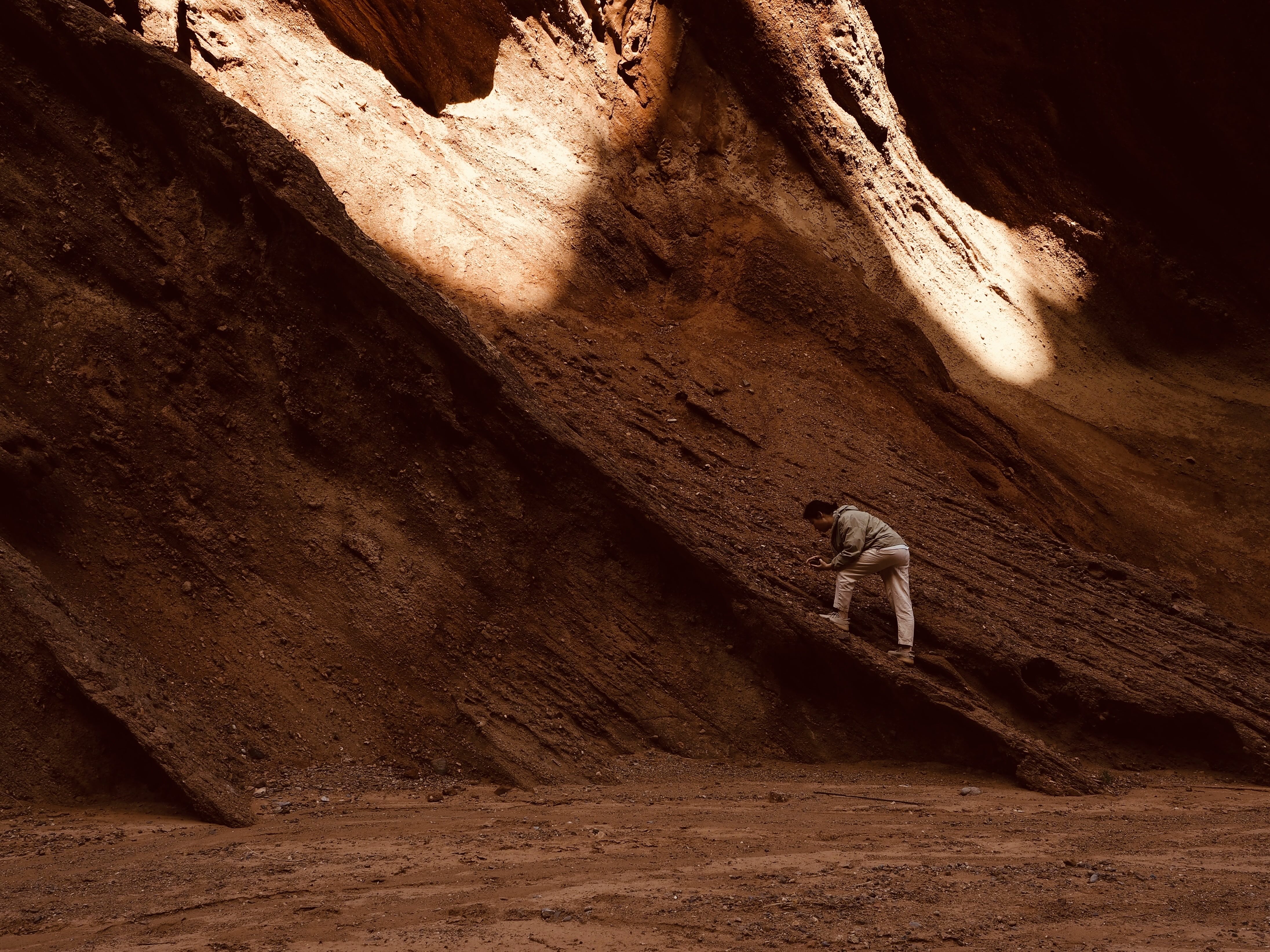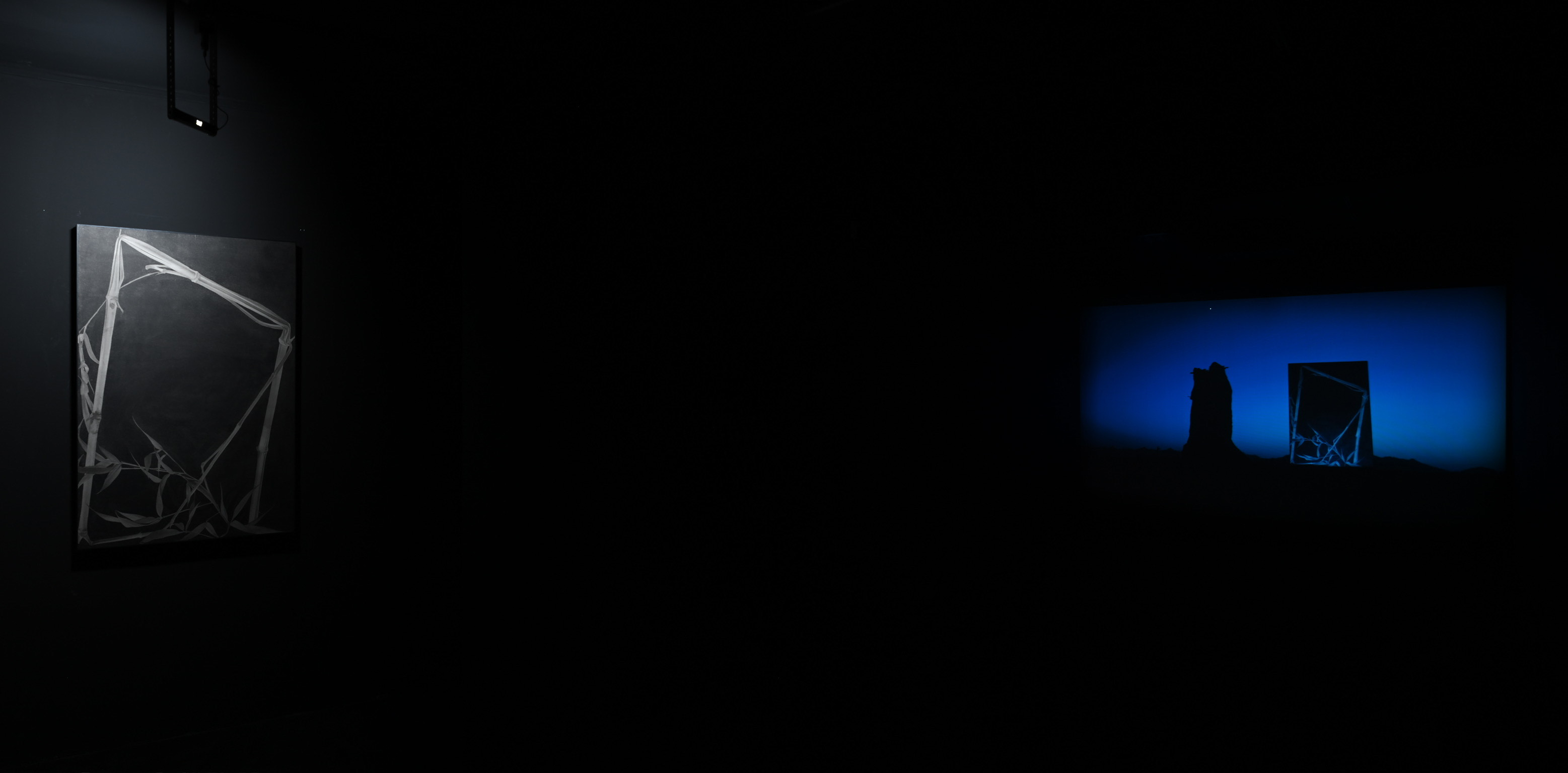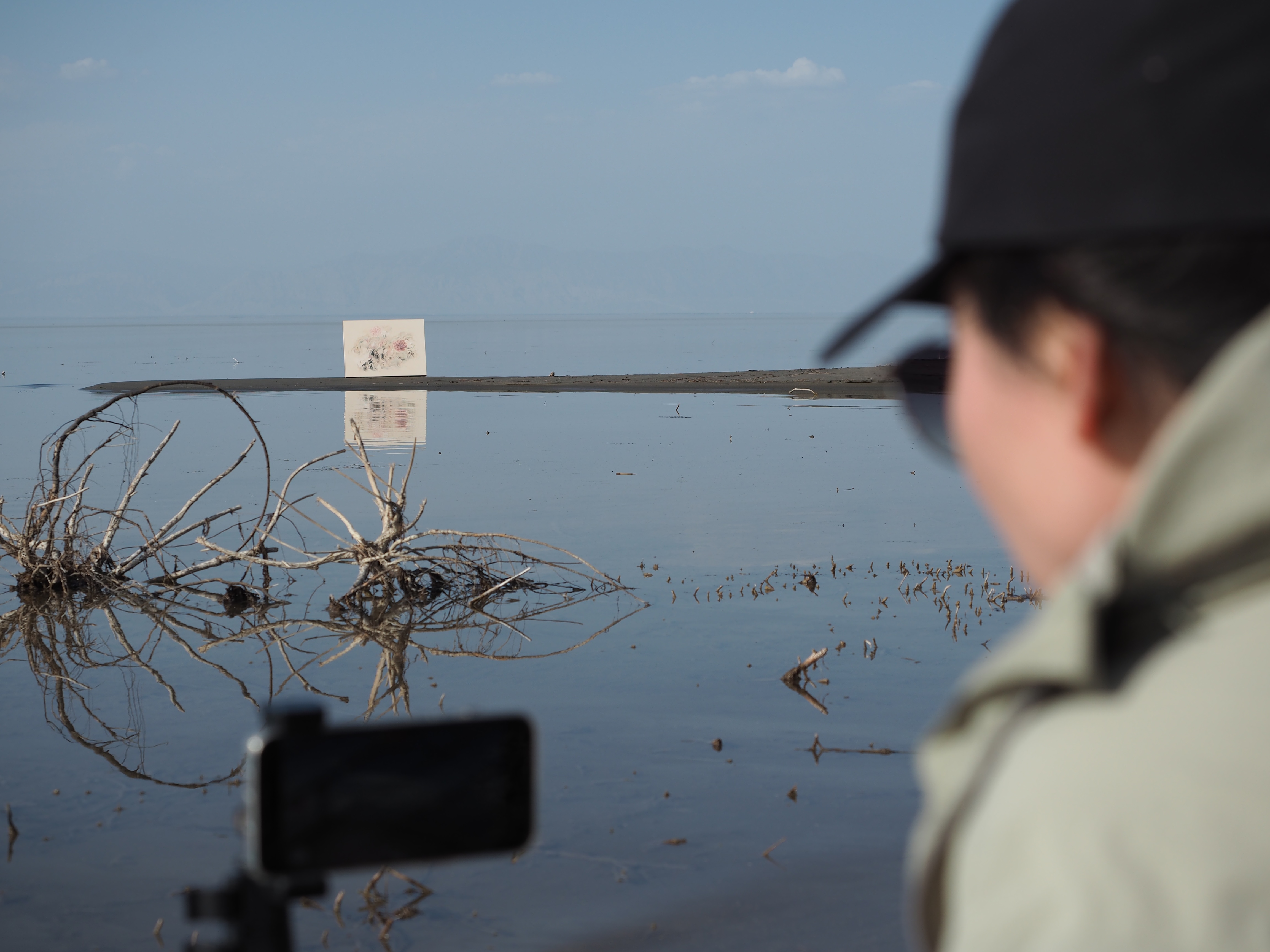Shows
“Observing My Distant Self”—Kang Chunhui’s Journey to the Inner Land

Observing My Distant Self: Kang Chunhui
INKstudio
Beijing
May 25–Aug 30
A vivid childhood dream persisted in the subconscious of painter and multidisciplinary artist Kang Chunhui (b. 1982, Urumqi, Xinjiang) for over three decades, resurfacing with renewed urgency in 2023. “Observing My Distant Self 73°40′E~96°23′E 34°25′N~48°10′N” (2019–23) is a multimedia project responding to Kang’s dream through a metaphorical pilgrimage back to the Western Regions, an area she left at the age of 18. Eight 2-meter-long synchronized videos juxtapose Kang’s artistic practice with historically, sociologically, and artistically significant Xinjiang locations that the artist has known since an early age: Kumtag Desert, Lop Nur, Bosten Lake, Tarim Poplar Forest, Kuqa Old Town, Tianshan Grand Canyon, Kizilgaha Beacon, and Kizil Caves.

KANG CHUNHUI in the Kizil Grottos researching the Buddhist mural paintings.

KANG CHUNHUI installing artwork in the Tarim Poplar Forest.
Trained in Chinese traditional meticulous (gongbi) and literati (xieyi) painting, Kang distinguishes herself through her contemporary reinterpretation of Buddhist mural iconography from the Kizil Caves, where she researched for two years (2006–08). In “Observing My Distant Self,” Kang critically examines her own artistic output by selecting representative pieces from her eight main pictorial series and placing them in designated Xinjiang locations. By returning these works to their inspirational origins, Kang observes them from afar against the natural landscape (with one urban exception in Kuqa Old Town). This process mirrors her approach to self-reflection, viewing her art with both familiarity and detachment, reminiscent of her early dream where she saw her childhood self atop a hill.

KANG CHUNHUI, Kuqa Old Town 82+0 93’12E – 41+0 72’47N, photo documentation material.
This project marks a significant shift in Kang’s artistic practice, integrating her long-dormant skills in video art (MFA from the National University of Seoul) and public art (BFA from Jiangnan University School of Design, Wuxi) with her established painting career. “Observing My Distant Self” is a large-scale multimedia installation comprising eight sections. Each section features a video depicting one or two works immersed in a landscape, with a fixed camera capturing subtle environmental changes. Accompanying these visuals are texts written by the artist, narrating specific stories related to each location. Kang further enriches the installation by incorporating materials retrieved from the original sites, such as sand, dried wood, and rocks. Finally, each section includes one or two pictorial artworks, varying based on the location. This multifaceted approach allows Kang to explore the interplay between her various artistic disciplines, creating a rich, immersive multisensory experience that bridges her past and more recent creative endeavors.

KANG CHUNHUI in the Tianshan Grand Canyon.
In “Tianshan Grand Canyon 83°05′35E–42°11′52N,” Kang Chunhui returns a painting primarily created with local clay to its original setting. This work exemplifies her artistic practices and themes, particularly the use of regional mineral and organic pigments. Kang, trained in one of China’s most culturally diverse areas, demonstrates expertise in selecting and preparing traditional pigments, often sourced from Western regions, for her ink paintings on paper. The painting, set against the canyon’s red rocky walls, depicts a semi-abstract, symbolic cluster of feathers encased in a milky, aura-like shape. This form evokes both Buddhist and Western religious iconography. The absence of a human figure recalls aniconic representations of Buddha predating anthropomorphic depictions, which emerged around the 1st century CE in Gandhara and Mathura. Feathers, a recurring motif in Kang’s “The Hidden Protagonist” series (2019– ), represent aesthetic beauty, resilience, and power to the artist. Their detailed rendering embodies a unique order, while their symbolism spans cultures from Chinese mythical creatures to Western angels. For Kang, Tianshan Grand Canyon serves as a liminal space, “[ . . . ] connecting interior and exterior, past and future, offering a sense of encompassing security.” [1]

KANG CHUNHUI, Kizilgaha 82+0 90’95E – 41+0 79’87N, ink and mineral pigment on paper, 120 × 90 cm; color video and sound; 6 min 6 sec. Courtesy INKstudio, Beijing.
The “Kizilgaha Beacon 82°90′95E–41°79′87N” installation represents “the meaning and imagination of a distant pursuit, [where] things seem to interchange their boundaries of hardness and softness.” [2] In this work, Kang juxtaposes video and painting to explore themes of history, resilience, and perception. The centerpiece is a night-time video capturing the silhouette of a Tang Dynasty fire beacon—a well-preserved relic of the ancient Silk Road’s northern route—against a starry sky. Adjacent to this, Kang presents a painting of a bamboo shoot, traditionally significant in Chinese literati art. The shoot, unnaturally bent and eerily lit from below, subverts conventional representations. This reimagining of bamboo symbolizes resilience and adaptability, qualities Kang associates with the plant’s tenacious root system. The artist manipulates scale in the video, presenting the painting as comparable in size to the 200-meter beacon. This visual device, along with the folded edges of the bamboo painting, challenges spatial perception and explores conceptual boundaries.

KANG CHUNHUI, Bosten Lake 87+0 02’58E – 41+0 92’46N, photo documentation material.
“Kizil Caves 82°51′35E–41°78′82N” marks the culmination of Kang’s journey to her artistic roots. Here, she presents one of her earliest red peony paintings—a flower traditionally symbolizing prosperity, honor, and beauty—at the entrance of a deliberately chosen empty cave. This symbolic gesture represents Kang’s alter ego: a gu vase-shaped composition with red-tinted roots resembling blood vessels, a stem like an umbilical cord, culminating in a vibrant red flower. [3] The complex pigmentation process, involving multiple mineral and organic sources (e.g. cochineal red, Tianshan clay, cinnabar), inspired her “Sumeru” pictorial series (2018-). “Kizil Caves 82°51′35E–41°78′82N” signifies Kang’s artistic liberation from past traditions, marking a rite of passage in her practice. As she states, “At the Kizil Caves, it was both the end of a journey and the beginning of a new departure. I wanted to confirm my relationship with color, art, and ink painting, which has now become clear. It's that I have actively and firmly chosen them this time, not because I painted as a child and therefore continue to do so now, nor is it related to my relationship with others. Now it begins as a dialogue with myself.” [4]
Kang’s future artistic direction, influenced by the “Kizilgaha Beacon 82°90′95E–41°79′87N” installation, aims to unify various elements. She envisions a synthesis of materials, environment, and natural approaches, creating a cohesive visual and sensory experience. Her focus will be on the interplay between nature, lighting, and ink materials, resulting in three-dimensional installations that transcend traditional ink painting.
[1] Kang Chunhui in an excerpt from an interview with the author, 30 July 2024.
[2] Ibid.
[3] Gu was an ancient Chinese bronze ritual wine vessel employed to drink wine or offer libations.
[4] Kang Chunhui in an excerpt from an interview with the author, 30 July 2024.
*This post is brought to you by INKstudio.







